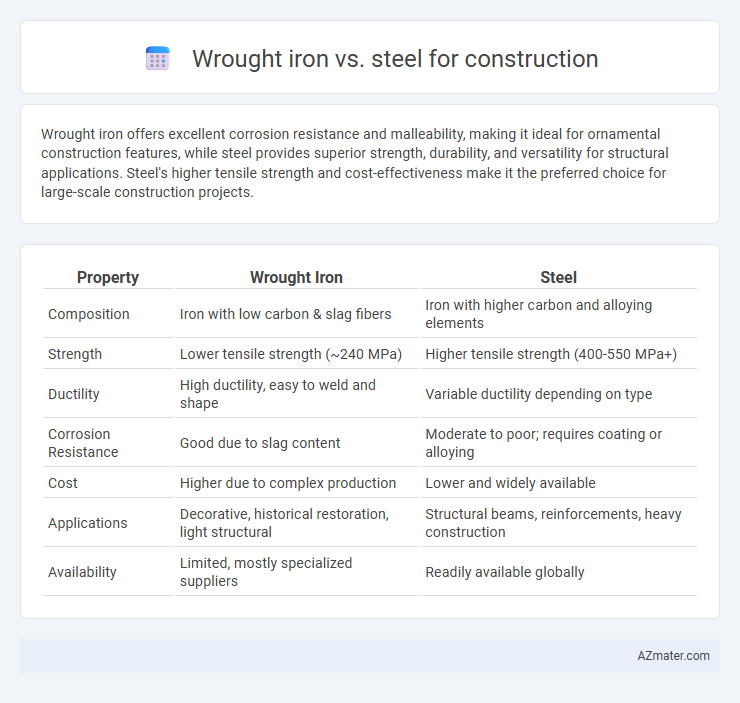Wrought iron offers excellent corrosion resistance and malleability, making it ideal for ornamental construction features, while steel provides superior strength, durability, and versatility for structural applications. Steel's higher tensile strength and cost-effectiveness make it the preferred choice for large-scale construction projects.
Table of Comparison
| Property | Wrought Iron | Steel |
|---|---|---|
| Composition | Iron with low carbon & slag fibers | Iron with higher carbon and alloying elements |
| Strength | Lower tensile strength (~240 MPa) | Higher tensile strength (400-550 MPa+) |
| Ductility | High ductility, easy to weld and shape | Variable ductility depending on type |
| Corrosion Resistance | Good due to slag content | Moderate to poor; requires coating or alloying |
| Cost | Higher due to complex production | Lower and widely available |
| Applications | Decorative, historical restoration, light structural | Structural beams, reinforcements, heavy construction |
| Availability | Limited, mostly specialized suppliers | Readily available globally |
Introduction: Wrought Iron vs Steel in Modern Construction
Wrought iron and steel serve distinct roles in modern construction due to their varying mechanical properties and durability. Wrought iron features low carbon content and high corrosion resistance, making it ideal for decorative elements and restoration work. Steel, characterized by its superior strength and versatility, dominates structural applications where load-bearing capacity and design flexibility are critical.
Historical Use of Wrought Iron and Steel
Wrought iron, historically favored for centuries due to its malleability and corrosion resistance, was widely used in classical construction for decorative elements and structural components before the Industrial Revolution. Steel, emerging prominently in the late 19th century, replaced wrought iron with superior tensile strength and versatility, revolutionizing modern construction and enabling skyscrapers, bridges, and reinforced concrete frameworks. The transition from wrought iron to steel marks a critical evolution in construction materials, reflecting advances in metallurgical processes and industrial capacity.
Composition and Manufacturing Processes
Wrought iron primarily consists of iron with a very low carbon content (typically less than 0.08%) and contains fibrous slag inclusions that enhance its corrosion resistance and malleability. Steel is an alloy of iron and carbon with varying carbon content (generally between 0.1% and 2.0%) and may include other alloying elements like manganese, chromium, and nickel to improve strength and durability. Manufacturing wrought iron involves puddling or hammering processes that expel impurities, while steel production uses modern methods such as the Basic Oxygen Furnace and Electric Arc Furnace, enabling precise control over its composition and properties for construction applications.
Mechanical Properties: Strength and Ductility
Wrought iron exhibits excellent ductility and corrosion resistance but has lower tensile strength compared to steel, making it less suitable for high-load structural applications. Steel offers significantly higher strength and can be alloyed to enhance both strength and ductility, providing superior performance in demanding construction environments. The choice between wrought iron and steel depends on the balance required between mechanical strength and deformation capacity for specific construction needs.
Durability and Corrosion Resistance
Wrought iron offers superior corrosion resistance due to its high slag content, making it more durable in outdoor and humid environments compared to standard carbon steel. Steel, particularly stainless steel, provides higher tensile strength and overall durability but requires protective coatings to prevent rust and corrosion in aggressive conditions. Choosing between wrought iron and steel for construction depends on the specific environmental exposure and structural strength requirements.
Architectural Aesthetics and Design Flexibility
Wrought iron offers exceptional architectural aesthetics with its intricate patterns, classic texture, and rustic charm, making it ideal for decorative elements like gates, railings, and ornamental features. Steel provides superior design flexibility, enabling sleek, modern structures with high strength-to-weight ratios, allowing for innovative shapes, large spans, and complex geometries in contemporary architectural projects. The choice between wrought iron and steel depends on balancing traditional visual appeal against modern structural versatility and customization options.
Sustainability and Environmental Impact
Wrought iron, composed primarily of iron with low carbon content, offers excellent corrosion resistance and durability, making it a long-lasting material with fewer replacements, thus reducing environmental waste. Steel, especially recycled steel, has a lower carbon footprint in production due to advancements in electric arc furnace technology and is highly recyclable, contributing to a circular economy. The energy efficiency of steel manufacturing and its potential for reuse often outweigh the traditional sustainability benefits of wrought iron in modern construction projects prioritizing low environmental impact.
Cost Comparison and Budget Considerations
Wrought iron typically incurs higher initial costs due to its labor-intensive forging process and limited availability compared to steel, which is mass-produced and widely accessible. Steel offers greater cost-efficiency in large-scale construction projects owing to its strength-to-weight ratio and lower maintenance expenses over time. Budget considerations must account for long-term durability, with steel often providing better value through reduced repair needs and faster installation.
Applications in Contemporary Construction Projects
Wrought iron, known for its excellent corrosion resistance and ductility, is primarily used in decorative elements such as gates, railings, and facade details in contemporary construction projects. Steel, with superior tensile strength and versatility, dominates structural applications including beams, columns, and reinforcements, ensuring durability and load-bearing capacity in modern buildings. The choice between wrought iron and steel largely depends on design requirements, with steel preferred for core structural frameworks and wrought iron selected for aesthetic, ornamental features.
Choosing the Right Material: Key Factors to Consider
Choosing between wrought iron and steel for construction involves evaluating factors such as strength, durability, and corrosion resistance. Steel offers higher tensile strength and versatility for structural applications, while wrought iron provides superior corrosion resistance and aesthetic appeal for decorative elements. Cost considerations and maintenance requirements also play crucial roles in determining the most suitable material for specific construction projects.

Infographic: Wrought iron vs Steel for Construction
 azmater.com
azmater.com